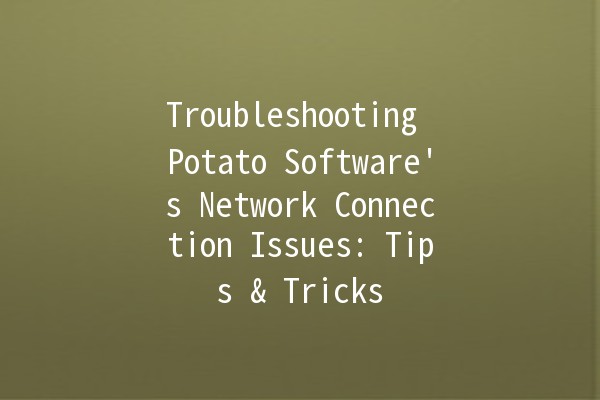In today's digital age, potato software has become an essential tool for many users. However, network connectivity issues can disrupt the seamless experience that users expect. This article aims to provide practical advice, tips, and tricks to help you resolve network connection problems while using potato software.
Understanding Potato Software and Its Network Requirements
Potato software is designed to facilitate various tasks, from game streaming to multimedia management. Like many applications, it requires a stable internet connection to function efficiently. Common challenges users encounter include slow downloads, interruptions in service, and complete disconnections. Identifying the underlying causes of these issues is the first step towards effective troubleshooting.
Why is Network Connection Important?
A stable network connection is crucial for several reasons:

Common Causes of Network Connection Issues
Before we dive into solutions, it’s crucial to understand the common causes behind network problems with potato software:
Improper Configuration: Incorrect settings in the software may lead to connectivity problems.
Network Congestion: Multiple devices using the same network can cause slowdowns.
Outdated Software: Using an older version of potato software may result in incompatible features.
Firewall or Antivirus Restrictions: Security software may block the application’s access to the internet.
ISP Issues: Sometimes, the problem lies with your Internet Service Provider (ISP) rather than with the software.
Productivity Enhancement Tips for Potato Software Users
Here are some essential productivity tips that can help you overcome network connection challenges and utilize potato software more effectively:
Explanation: Reviewing and optimizing your network settings can lead to improved performance.
Practical Application: Access your router settings and ensure Quality of Service (QoS) is enabled. This feature helps prioritize bandwidth for potato software. You can also adjust the router's channel to minimize interference from other nearby networks.
Explanation: Keeping your potato software updated ensures that you have the latest features and bug fixes, which may resolve connectivity issues.
Practical Application: Set up automatic updates for potato software, or check for updates manually by navigating to the settings menu and looking for the “Check for Updates” option. Regular updates can also enhance security.
Explanation: Wireless networks can be unstable, especially in environments with many devices.
Practical Application: If possible, connect your device directly to your router using an Ethernet cable. This direct connection often results in faster and more reliable internet access, significantly reducing latency.
Explanation: Firewalls are essential for protecting your device, but sometimes they can mistakenly block potato software's access to the internet.
Practical Application: Access your firewall settings and create an exception for potato software. On Windows, you can do this by going to “Windows Defender Firewall,” selecting “Allow an app or feature through Windows Defender Firewall,” and adding potato software to the allowed list.
Explanation: Keeping an eye on how your network resources are being used can help identify the source of connectivity issues.
Practical Application: Use network monitoring tools such as GlassWire or NetBalancer to analyze bandwidth usage on your network. This allows you to identify which devices or applications are consuming the most bandwidth and manage them accordingly.
Troubleshooting Steps for Potato Software Connection Problems
If you're facing issues with potato software's connectivity, follow these troubleshooting steps:
Restart Your Router & Device
This simple method can resolve many issues related to the network configuration. Unplug your router, wait for about 30 seconds, and plug it back in. Additionally, restarting your device can clear temporary glitches that may be causing connection issues.
Check for Updates
Besides keeping the potato software updated, also ensure your operating system and network drivers are the latest versions. An outdated driver may contribute to connectivity issues.
Reset Network Settings
If you’re encountering persistent issues, consider resetting your network settings. On Windows, you can access this by going to “Settings” > “Network & Internet” > “Status” > “Network reset.” Be aware that this will remove all saved networks.
Disable VPN or Proxy Services
If you are using a VPN or proxy service, it may interfere with the operation of potato software. Temporarily disable these services to see if connectivity improves.
Test Different Networks
If possible, connect your device to a different network. This will help determine whether the issue lies with your network or the potato software itself.
Frequently Asked Questions
If you experience frequent disconnections, the first step is to check your internet connection. Look for any interruptions or slowdowns. Ensure your router is functioning correctly and consider connecting directly via Ethernet. Additionally, check your firewall settings to confirm the application isn't being blocked.
Testing your internet connection on other devices or applications can help you determine where the problem lies. If other applications also face issues, it’s likely a network problem. However, if only potato software is affected, you may need to troubleshoot the application itself.
For optimal use, ensure that your router is configured with quality of service (QoS) settings to prioritize potato software. Also, using a dualband router is beneficial; connecting to the less congested 5 GHz band can improve performance.
Slow loading times may stem from network congestion or an overloaded server. If multiple devices use the same network, bandwidth can be strained. Schedule heavy downloads or streaming for times when fewer users are online to alleviate this issue.
Yes, background applications consuming bandwidth can significantly impact potato software’s performance. Use network monitoring tools to identify and limit these applications during crucial usage times.
If you've exhausted all troubleshooting options without success, consider reaching out to potato software's customer support. They may provide additional solutions or confirm if there is a widespread outage affecting connectivity.
By following these detailed tips and troubleshooting methods, you can enhance your experience with potato software, ensuring a smoother and more productive interaction. Don’t hesitate to dive deeper into each suggestion and adapt them according to your specific situation. Happy troubleshooting!